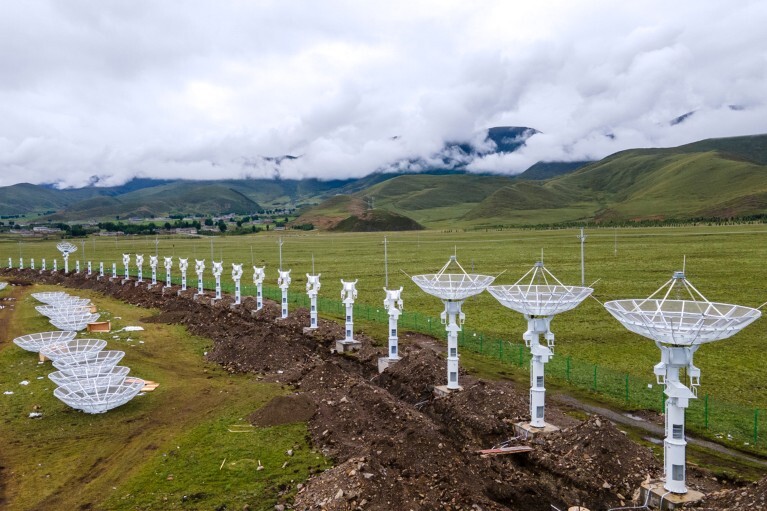15.11.2022
China’s Daocheng Solar Radio Telescope is among a suite of instruments the country has built in the past three years to study the Sun.

A huge ring of radio antennas in China will help researchers to study eruptions in the Sun’s outer atmosphere. Credit: Liu Zhongjun/China News Service/Getty
On the edge of the Tibetan Plateau, engineers just finished mounting the final pieces of hardware onto the world’s largest telescope array for studying the Sun.
Construction of the Daocheng Solar Radio Telescope (DSRT), which consists of more than 300 dish-shaped antennas forming a circle more than 3 kilometres in circumference, was completed on 13 November. Trial operations will begin in June. The 100 million yuan (US$14 million) observatory will help researchers to study solar eruptions and how they affect conditions around Earth.
“We are entering the golden age of solar astronomy as we have lots of major solar telescopes coming online,” says Maria Kazachenko, a solar physicist at the University of Colorado, Boulder. These include NASA’s Parker Solar Probe, launched in 2018, and the European Space Agency’s Solar Orbiter, launched in 2020, both of which collect data as they orbit the star.
The Sun is set to enter a highly active phase over the next few years. The radio-frequency data DSRT collects will complement those gathered by telescopes working in other frequency bands. In the past two years, China has launched at least four Sun-gazing satellites — including the Advanced Space-based Solar Observatory in October — that study the star at ultraviolet and X-ray frequencies. “China now has instruments that can observe all levels of the Sun, from its surface to the outermost atmosphere,” says Hui Tian, a solar physicist at Peking University in Beijing.
Observatories in China will also provide important data on solar activities that are not visible to telescopes in other time zones, says Ding Mingde, a solar physicist at Nanjing University. Solar research requires global collaboration, he adds.
Stellar explosions
Radio telescopes such as DSRT are useful for studying activities in the Sun’s upper atmosphere — the corona — such as solar flares and coronal mass ejections (CMEs). These are giant eruptions of hot plasma from the corona that occur when the Sun’s twisted magnetic field ‘snaps’ and then reconnects. When the high-energy particles released during a CME hurtle towards Earth, the resulting ‘space weather’ can damage orbiting satellites and disrupt power grids on Earth.
In February, a relatively weak CME destroyed 40 Starlink communications satellites launched by SpaceX, an aerospace company in California. “With an increasing number of satellites in space, there’s an increasing need to better forecast space weather,” says Ding.
Kazachenko says that predicting space weather remains a struggle. DSRT has a wide field of view, at least 36 times bigger than the Sun’s disk, which will allow the telescope to track the development of CMEs and observe how high-energy particles propagate through space, says Jingye Yan, the chief engineer of DSRT at the National Space Science Center, part of the Chinese Academy of Sciences, in Beijing. “With this information, we may be able to forecast whether and when coronal mass ejections will reach Earth,” says Yan.
DSRT’s 313 antennas will allow it to achieve high sensitivity for better space weather forecasting. The large array could potentially capture weaker signals from high-energy particles that might be missed by arrays observing at the same frequency range — from 150 megahertz to 450 megahertz — with fewer antennas, such as the Nançay Radioheliograph in France, which has 47 antennas, says Yan.
DSRT’s observation data will be made available to international researchers, says Yan. And China’s National Space Science Center, which oversees DSRT’s operation, plans to open the telescope at night for other types of observation, such as pulsar research. China is also building a new optical telescope on the Tibetan Plateau in Sichuan that is expected to be completed in 2026.
Quelle: nature

